
FS-2022-0640 | October 2022
From the Orchard to Cold Storage: A Closer Look at the Development of Nine Physiological Disorders in Apples
What are physiological disorders and what factors trigger their development?
Physiological disorders are abnormalities within the different apple fruit tissues that lead to a loss of quality, marketability, and profitability, and therefore an increase in fruit loss and waste. Physiological disorders are not caused by pathogens or mechanical damage, but can be a result of abiotic factors, such as genotype/genetic background (cultivar/strain); maturity at harvest time; orchard/preharvest factors; seasonal variations; and postharvest storage conditions.
Different cultivars are more prone to developing certain disorders than others. For example, Honeycrisp fruits are highly prone to bitter pit development. Growers and researchers demonstrate that fruit that is harvested too early is more prone to developing bitter pit, while fruits that are harvested too late (overripe) are prone to developing chilling injury. Some late-ripening cultivars, such as Fuji, are more susceptible to disorders such as watercore. Preharvest factors such as tree fruit mineral nutrition, rootstock selection, or crop load play a key role in the development of physiological disorders, as bitter pit is exacerbated in Honeycrisp fruit with low calcium (Ca) levels and larger sizes. Additionally, environmental variations such as high temperatures, increased precipitation, or excessive sunlight exposure can trigger physiological disorder development. Finally, postharvest storage conditions, such as humidity levels, temperature, and gas concentrations, which are key to maintaining fruit quality during storage, can also increase susceptibility to physiological disorders.
In this factsheet we will take a closer look at nine physiological disorders that can develop in apples during postharvest storage, but can be triggered by the different factors described above. We will briefly discuss their symptoms, why and when they develop, and how can they be prevented.
1. Bitter Pit
Some susceptible cultivars: Braeburn, Cortland, Golden Delicious, Granny Smith, Honeycrisp, Jonagold
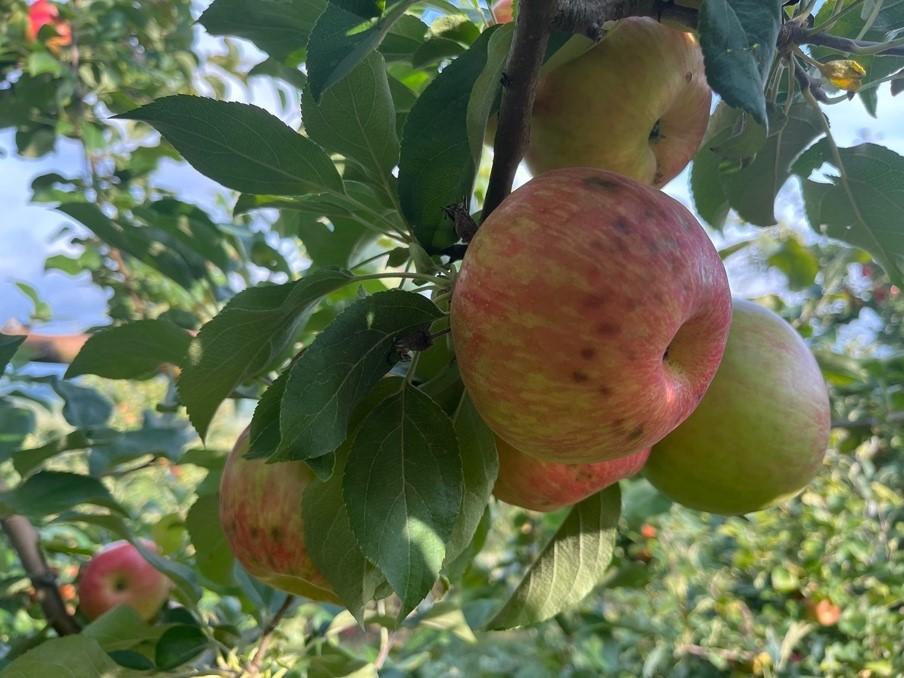
What is it? What are its symptoms? Slightly water-soaked pits, which have dark, dry, sunken areas where tissues are depressed. The flesh is brown. It typically develops on the calyx end of the fruit.
What causes it? Caused by an imbalance in Ca levels in the fruit. Ca is one of the key components of the cell membranes, so the low Ca in the cells causes the cells to become leaky and break down, leading to cell death. Pits are pockets of these dead cells. It can also be caused by excessive nitrogen (N), potassium (K), and magnesium (Mg) levels, and low boron (B) levels. B helps the movement of Ca, so if B is low then Ca levels will also be low. Excessive K and Mg levels can depress the Ca in the fruit.
When does it begin to develop and when is it observed? Starts to develop after petal fall and can be expressed on the tree, but will be found during the first 2 months of storage. In Honeycrisp, bitter pit will be exacerbated in fruits that are conditioned (7 days at 50°F) before cold storage (38°F).
What practices can avoid its development? Choosing the correct rootstock and focusing on nutritional management and crop load are key aspects to decrease bitter pit development, while preharvest foliar calcium sprays should be used to complement these practices. Drenching immediately harvested apples in a calcium solution before storage may work as a complementary practice.
2. Carbon Dioxide Injury
Some susceptible cultivars: Braeburn, Cortland, Empire, Fuji, Golden Delicious, Honeycrisp, McIntosh
What is it? What are its symptoms? Characterized by the expression of external injury in the skin that will form brown sunken lesions that can join to form one very large patch, as well as by the expression of internal injury as discolored areas within the vascular bundles, forming cavities or pockets in the flesh with tissue that can become dry. A strong fermentation aroma may be present.
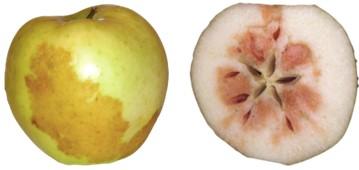
What causes it? Caused by high carbon dioxide levels (> 0.5%), and low oxygen levels (<1.5%) during controlled atmosphere storage.
When does it begin to develop and when is it observed? This disorder is induced early during postharvest storage (within the first few months), and symptoms will appear as storage progresses until apples are taken out of the high carbon dioxide conditions.
What practices can avoid its development? Maintain low levels of carbon dioxide in storage atmospheres during early controlled atmosphere. Delay the application of controlled atmosphere storage. Avoid the use of 1-methylcyclopropene (1-MCP) in storage. Applying Diphenylamine (DPA) can help control this disorder.
3. Lenticel Blotch Pit
Some susceptible cultivars: Braeburn, Fuji, Gala, Golden Delicious, Honeycrisp, Red Delicious

What is it? What are its symptoms? Expressed as hard, asymmetrical brown patches around the lenticels and near the calyx end of the fruit or the blushed side of the skin. They also produce dry brown sponge-like spots on the flesh of the apples.
What causes it? Caused when fruit is harvested too late in the season. Incidence also increases due to hot summers (> 90° F), and due to excessive N concentrations and low Ca levels, as the latter decreases flesh fruit firmness. The development of lenticel blotch pit is also commonly associated with postharvest practices such as delayed conditioning, as these hasten ripening, and therefore increase and deepen these depressions over time.
When does it begin to develop and when is it observed? The development of lenticel blotch pit can be visible right before harvest, but it especially appears during storage, usually when fruit are being packed.
What practices can avoid its development? Avoid practices that hasten ripening as well as harvesting fruit too late in the season and avoid excessive N levels, as growers and researchers report that Ca sprays decrease the incidents of lenticel blotch pit.
4. Lenticel Breakdown
Some susceptible cultivars: Ambrosia, Fuji, Gala, Honeycrisp
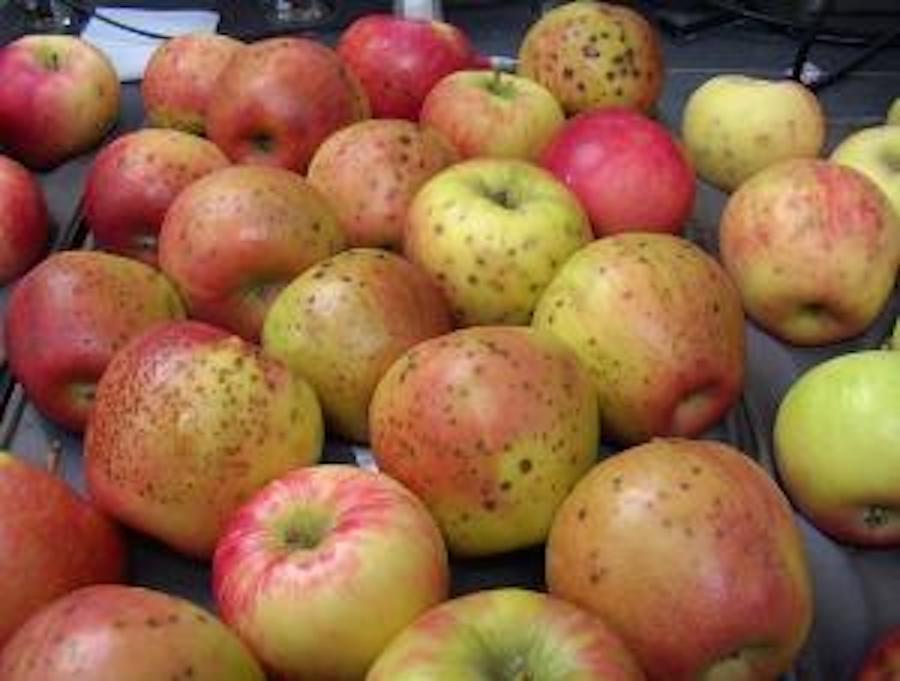
What is it? What are its symptoms? This disorder occurs as a result of irregular water retention and can be found mainly on apple skin around the lenticels (small natural openings in the cuticle of apples), on both blushed and shaded side of the fruit. They are characterized by precise circular darkened spots concentrated in multiple areas on the skin. Early symptoms are similar to small dimples when observed in angled light. During storage, as flesh firmness decreases, spots grow in depth and diameter and may combine. Flesh is not generally affected.
What causes it? Caused by microcracks and abrasions that form on the skin layer of apples preharvest. These microcracks and abrasions can occur due to irregular water supply, high humidity (> 95%), and low wind. The disorder is the result of influxes of water and low rates of evapotranspiration that cause fluctuations in the amount of water within the apples.
When does it begin to develop and when is it observed? There is little evidence of the disorder before packing, but it will develop after a few days of storage.
What practices can avoid its development? Avoid irregular water supply to apple fruits and unbalanced nutrition preharvest. Avoid harvesting apples late in the season and avoid larger apples, as risk of disorder development will increase. Because excessive storage periods in overripe fruit are also associated with higher disorder risk, avoid delaying cooling postharvest as fruit continues maturing.
5. Senescent Scald
Some susceptible cultivars: Golden Delicious, Idared, Jonagold
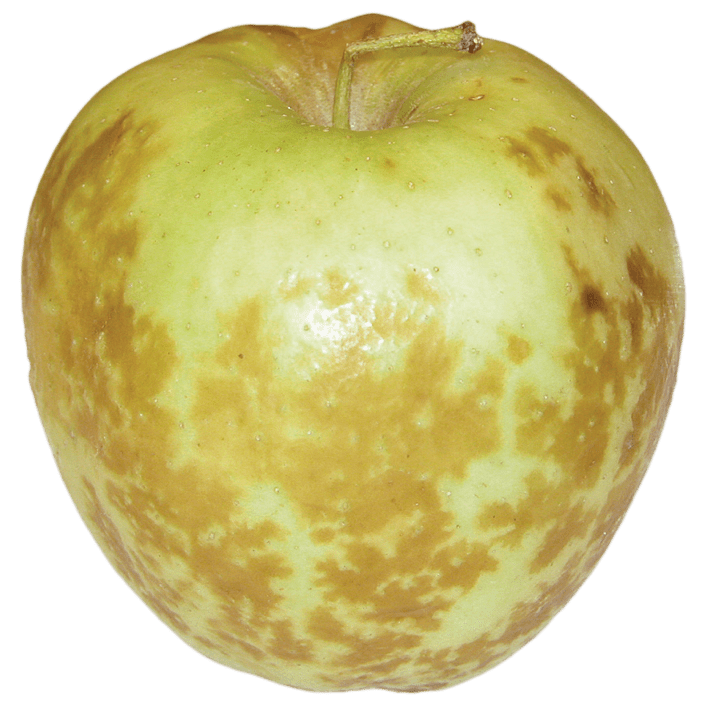
What is it? What are its symptoms? Expressed as brown patches that may become sunken and rough with distinct margins. Generally, appears on the blushed side of the fruit, which is exposed to sunlight. The interior of the fruit may have brown flesh.
What causes it? This disorder is caused due to harvesting fruit late and storing it for > 4-5 months when picked for short-term storage and >12 months when picked for long term storage.
When does it begin to develop and when is it observed? Can begin preharvest as a result of sun exposure and late harvesting, but can also be observed during postharvest storage.
What practices can avoid its development? Avoid late harvests if fruit will be stored for long-term, and minimize excessive sunlight exposure by managing the tree canopy.
6. Soft Scald
Some susceptible cultivars: Fuji, Golden Delicious, Honeycrisp, McIntosh
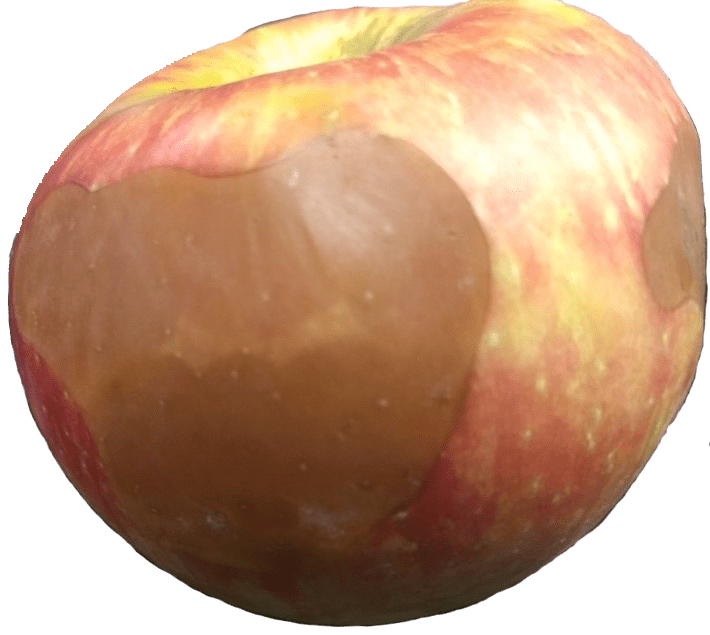
What is it? What are its symptoms? Postharvest disorder caused by chilling injury where apples form brown soft sunken discoloration patches in the skin tissue. This discoloration is irregular, but is sharply demarcated and clearly defined. In severe cases it can cover nearly the entire apple skin.
What causes it? It develops when the fruit is directly stored at temperatures <37°F without a conditioning treatment (storage at 50°F for 7 days).
When does it begin to develop and when is it observed? The symptoms will develop and be visible generally after the first two months of storage of fruits <37°F.
What practices can avoid its development? Fruits should be preconditioned at 50° F for 7 days, and only then stored at 38° F for several months.
7. Soggy Breakdown
Some susceptible cultivars: Fuji, Golden Delicious, Honeycrisp, McIntosh
What is it? What are its symptoms? Postharvest disorder caused by chilling injury where the apple flesh (cortex) tissue turns brown, soft, and spongy. In severe cases, complete rings of brown flesh tissue can form.
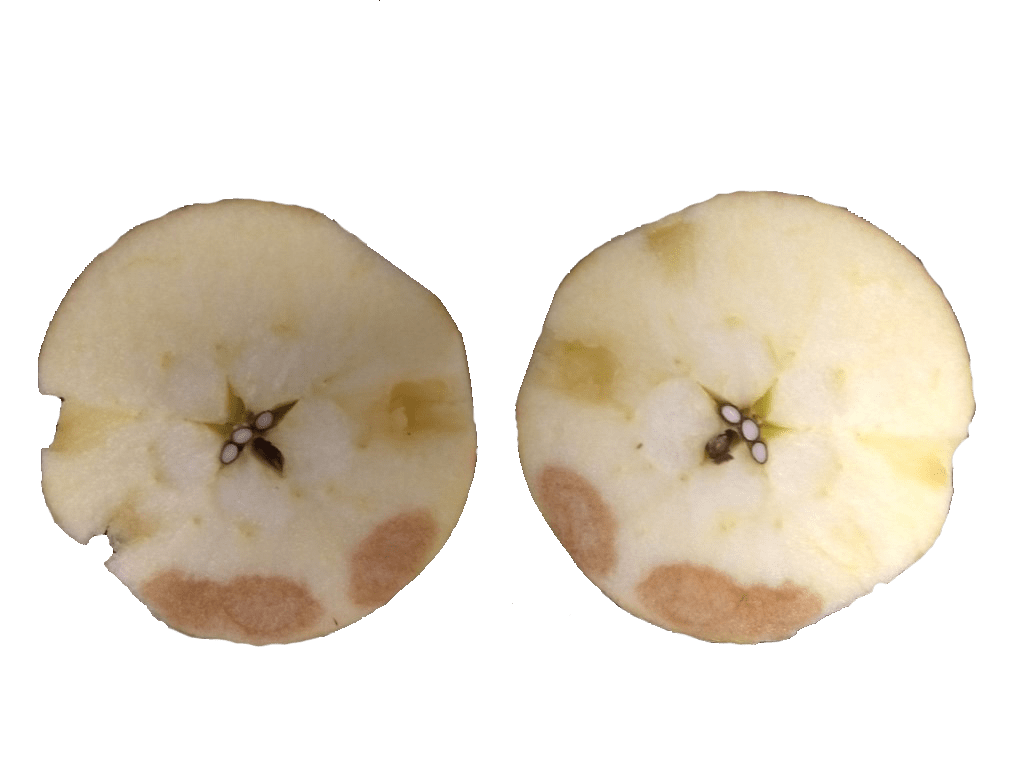
What causes it? It develops when the fruit is directly stored at temperatures <37°F without a conditioning treatment (storage at 50°F for 7 days). Susceptibility also increases in fruits that are harvested late, and in large fruits with light crops. Cooler temperatures and excess moisture near harvest also increase the disorder. The disorder is highly correlated with soft scald development.
When does it begin to develop and when is it observed? The symptoms will develop and be visible generally after the first two months of storage of fruits <37°F.
What practices can avoid its development? Fruits should be preconditioned at 50° F for 7 days, and only then stored at 38° F for several months.
8. Superficial Scald
Some susceptible cultivars: Cortland, Fuji, Granny Smith, McIntosh, Red Delicious

What is it? What are its symptoms? Postharvest disorder caused by chilling injury that is restricted to the skin of the apple, usually on the shaded side. Symptoms are diffuse/irregular dry brown patches on the skin that could be accompanied by a rough texture. Develops rapidly when the fruits are transferred from cold storage to room temperature.
What causes it? Oxidation of alpha-farnesene causes the browning. Fruits are highly susceptible when harvested physiologically less mature; when they have not received a cumulative of 150 hours in temperatures below 50° F; when they have been exposed to temperatures >77 ° F during the month before harvest; when they are grown in warmer and drier climates; and when they are grown with high K, high N, and low Ca.
When does it begin to develop and when is it observed? It can develop during cold storage and it can be enhanced 3-7 days after taking the fruit out of storage to room temperature (>3 months in storage).
What practices can avoid its development? Application of antioxidants within the first week of harvest (for example, applying Diphenylamine (DPA) prevents accumulation of alpha-farnesene oxidation products); removing or scrubbing ethylene from storage; applying 1-MCP (1- methylcyclopropene) after harvest; increasing ventilation rates; using ultra-low oxygen storage (particularly for organic apples).
9. Watercore
Some susceptible cultivars: Fuji, Jonagold, Red Delicious
What is it? What are its symptoms? Watercore is characterized by water-soaked tissues in the apples’ core. It usually only affects the flesh. In severe cases, it may extend to the flesh cells under the skin and produce flesh browning and tissue fermentation during storage.
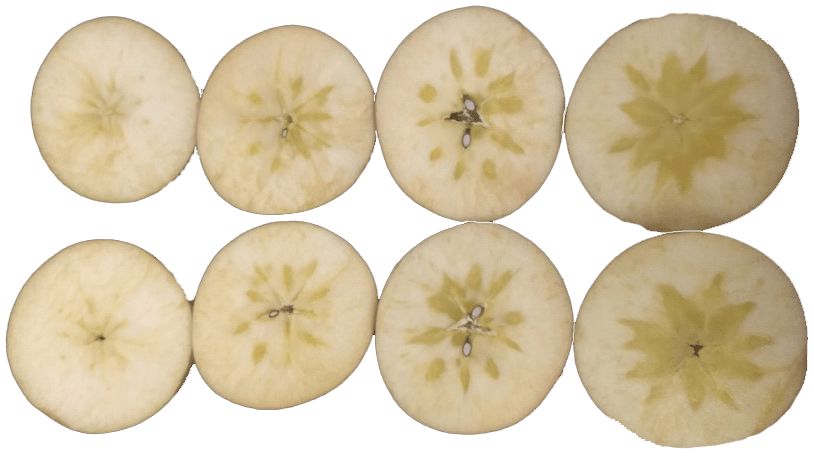
What causes it? It is caused by the accumulation of sorbitol-rich liquid (which is the primary transport carbohydrate of apples) in the intercellular spaces of the apple tissue. The accumulation of sorbitol-rich liquid attracts water to the cells, causing this translucent, glossy aspect.
When does it begin to develop and when is it observed? Watercore begins to develop on the tree preharvest. As apples get closer to maturity, these can express symptoms at harvest. However, if the watercore is slight or moderate, it can disappear during storage.
What practices can avoid its development? Harvesting apples at the appropriate stage of maturity will decrease the likeliness of watercore, as well as maintaining a uniform tree nutritional balance and avoid excessive vigor. The use plant growth regulators to delay ripening can reduce watercore incidence, but might negatively affect fruit skin red coloration.
Conclusions
Apple fruits are affected by several physiological disorders that can develop on the tree, at harvest, or during storage. These physiological disorders can result from several abiotic factors which affect the fruit and will directly lead to a loss of quality, marketability and profitability. This in turn leads to increased fruit loss and waste. Understanding which apple cultivars are more susceptible to different physiological disorders as well as the disorders’ typical symptoms is critical to reducing or avoiding their incidence. It is also essential that growers recognize what causes these disorders and the practices that can prevent their development.
References
- Al Shoffe, Y., Watkins, C. 2021. Common Storage Disorders of Apple Fruit. Tree Fruit News, 9 (5), 1-5. Cornell Cooperative Extension.
- Blakey, R. Superficial Scald Management in Apples. Washington State University. http://treefruit.wsu.edu/article/superficial-scald-management-in-apples/
- Cline, J. 2016. Bitter Pit Control in Apples. Ontario Ministry of Agriculture, Food and Rural Affairs, Ontario, Canada. http://omafra.gov.on.ca/english/crops/facts/00-009.htm
- Fallahi, E., Mahdavi, S. 2020. Physiological and environmental factors influencing bitter pit in apples. Journal of Horticultural Science and Research. https://scholars.direct/Articles/horticulture/jhsr-3-011.pdf
- Lurie, S., Watkins, C.B. 2012. Superficial scald, its etiology and control. Postharvest Biol. Technol. 65, 44–60. https://doi.org/10.1016/j.postharvbio.2011.11.001
- Naeve, L., Domoto, P. 2008. Harvesting and storing apples. Iowa State University Extension and Outreach. https://store.extension.iastate.edu/Product/4409
- Singh, V., Gamrasni, D., Arie, R. B., Naschitz, S., Friedman, H. 2016. Identification of open lenticels in apples after harvest in relation to lenticel breakdown development during storage. Postharvest Biol. Technol. 121, 165–170. https://doi.org/10.1016/j.postharvbio.2016.06.004
- The University of Maine Cooperative Extension. Storage Disorders. https://extension.umaine.edu/fruit/harvest-and-storage-of-tree-fruits/storage-disorders/
- Washington State University Extension. Physiological Disorders. Tree Fruit Postharvest Export Education | Washington State University. http://tfrec.cahnrs.wsu.edu/postharvest-export/physiological-disorders/
CARLOS CORTE
Candidate for B.S. in Biochemistry
MACARENA FARCUH, PH.D.
Assistant Professor and Extension Specialist
mfarcuh@umd.edu
This publication, From the Orchard to Cold Storage: A Closer Look at the Development of Nine Physiological Disorders in Apples (FS-2022-0640) is a part of a collection produced by the University of Maryland Extension within the College of Agriculture and Natural Resources.
The information presented has met UME peer-review standards, including internal and external technical review. For help accessing this or any UME publication contact: itaccessibility@umd.edu
For more information on this and other topics, visit the University of Maryland Extension website at extension.umd.edu
University programs, activities, and facilities are available to all without regard to race, color, sex, gender identity or expression, sexual orientation, marital status, age, national origin, political affiliation, physical or mental disability, religion, protected veteran status, genetic information, personal appearance, or any other legally protected class.